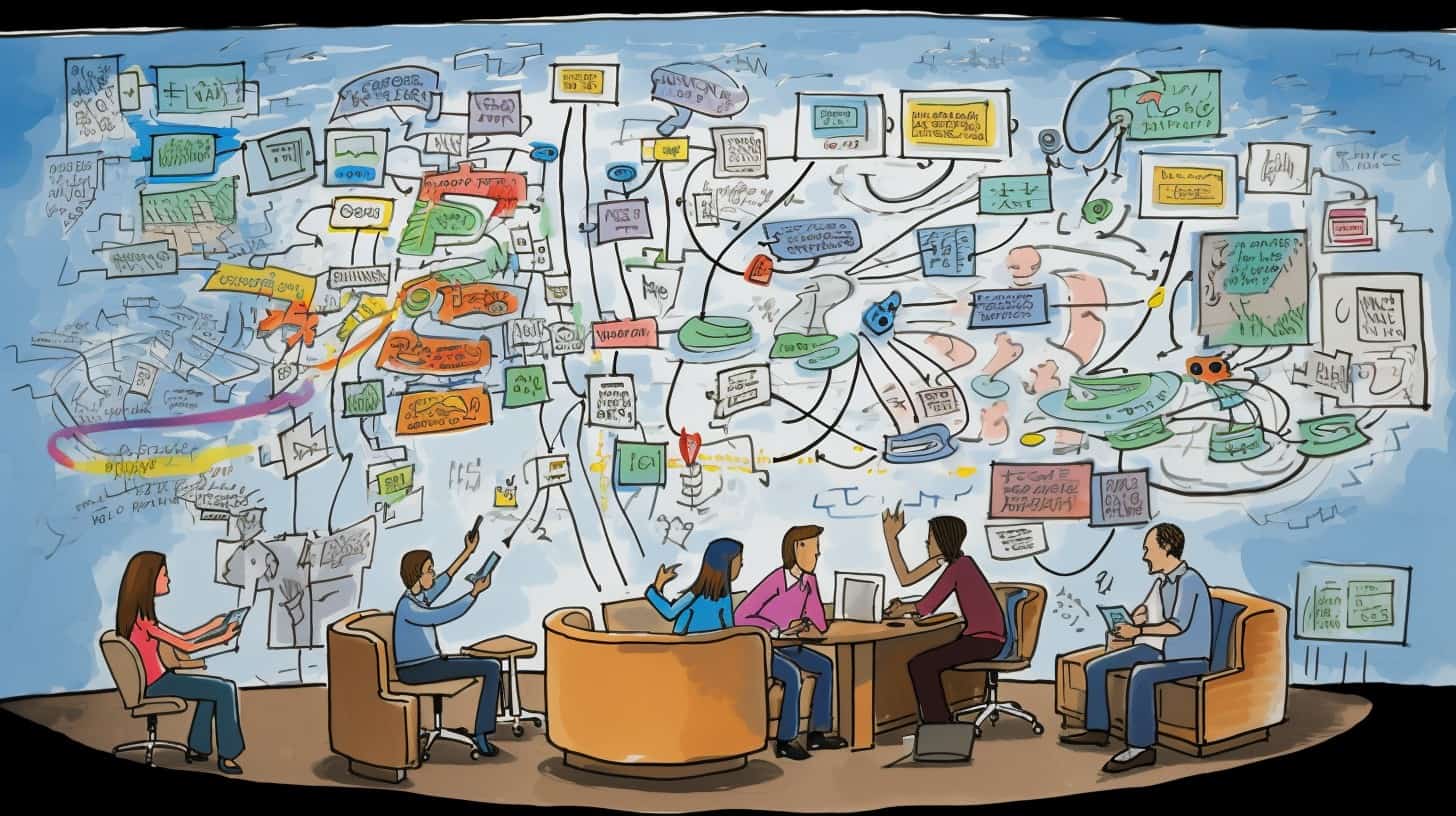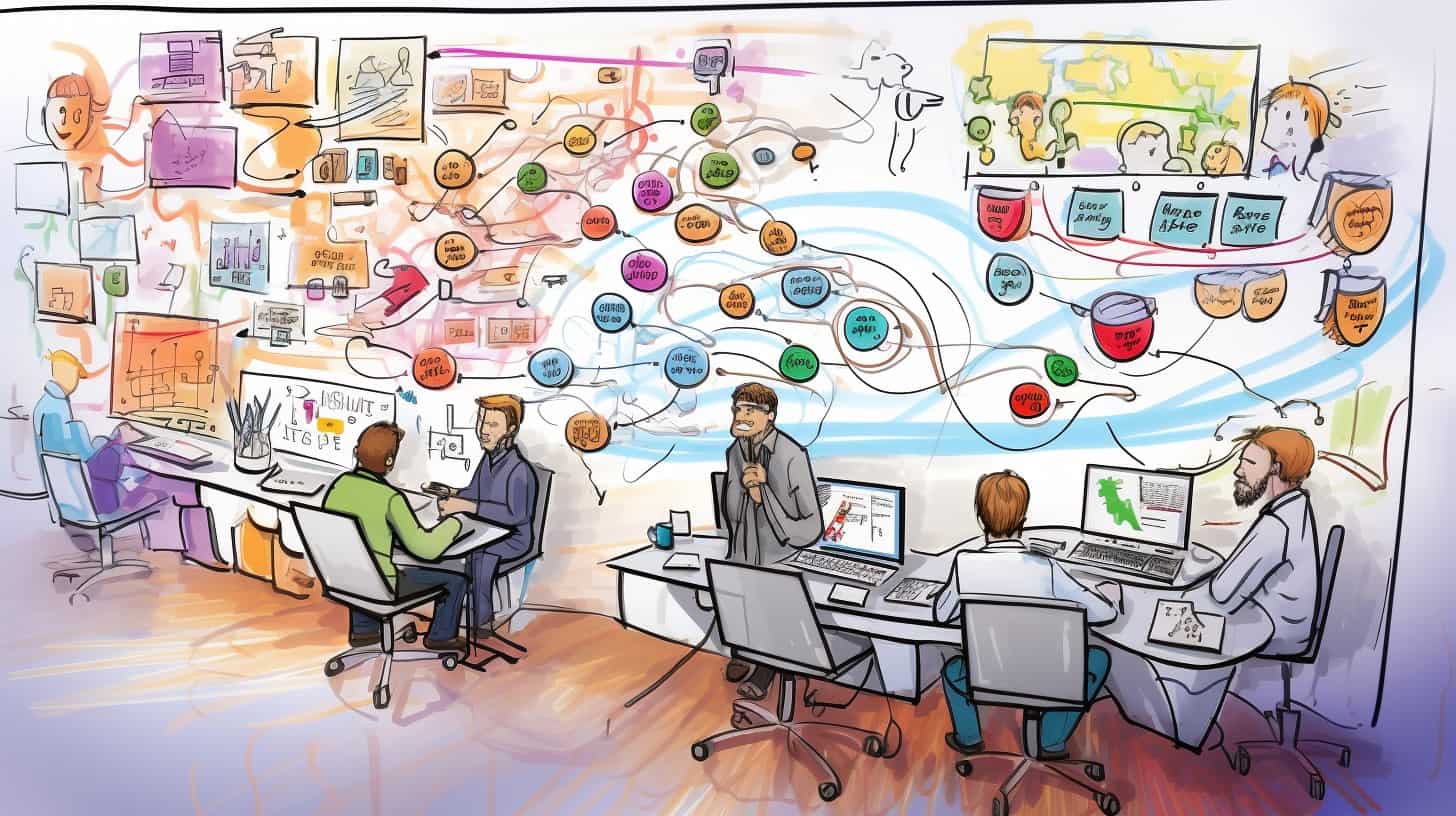Navigating the labyrinthine world of software design and software design services can be daunting—a challenge that many have grappled with, including myself. After a decade dedicated to perfecting this craft, I’ve poured my experience into uncovering the secrets behind each complex layer.
Within these pages lies a treasure trove of knowledge — crystal-clear insights paired with practical steps to untie the perplexing knots of software design. From foundational principles to sophisticated methodologies, this is your handbook for illumination and mastery in the art of creating software.
Prepare yourself to embark on a journey toward unclouded understanding.
Key Takeaways
Software design is like a blueprint for building programs that meet user needs and work well.
It uses concepts like abstraction and modularity to break big jobs into smaller parts, making it easier to manage and change later.
The design includes things like how users will interact with the software (UI/UX) and keeping data safe (security).
Good design helps make sure the software can grow (scalability), run fast (performance), and be easily updated (maintainability).
Table of Contents
Defining Software Design

In the realm of software development, design is the cornerstone that holds our intricate systems together. It’s not merely a stage in creation; it’s a multifaceted discipline where functionality and form converge to mold user experience, performance, security, and maintainability into coherent digital solutions.
Software design is the process of envisioning and defining software solutions to one or more sets of problems
https://en.wikipedia.org/wiki/Software_design
At its core, software design serves as the master plan for developers, providing clear blueprints on how to transform customer requirements into functional programming code. This blueprint encompasses everything from algorithms and data structures to interface layouts and system interactions.
By breaking down complex ideas into manageable modules through this process, we lay out a definitive pathway toward building robust programs that stand the test of evolving user needs and technological advancements.
The Role of Software Design in Development
I imagine software design like a blueprint for a house. Just as you need plans to build a house, you need good software design to create programs that solve problems. It’s where I decide how the software will look and work before writing any code.
This planning helps figure out what the user needs and how to make everything fit together nicely.
Software design lets me break down big tasks into smaller parts. Each part, or module, does one thing well and talks to other modules in clear ways. That means less confusion for everyone who works on the project later on.
Plus, it makes it easier to test things out and change them if we have to without breaking anything else. It’s super important because it can save time and money by finding issues early instead of after everything is built.
The Components of Software Design
Let me tell you about the parts that make up software design. It’s like putting together a big puzzle where each piece must fit just right.
- Abstraction: This is all about making things simple. When I work with abstraction, I don’t worry about all the small details at first. Instead, I focus on the big idea or main goal of what the software needs to do.
- Refinement: Once I have the basic idea down, it’s time to add more details. Refinement means taking my simple design and making it better and clearer by filling in those details.
- Modularity: Here’s where we break the system into smaller parts or modules. Each part has its job and can be worked on separately without messing up everything else.
- Software Architecture: This is the plan for how all those modules fit together. It’s like a map that shows which part of the software connects to another.
- Control Hierarchy: It’s important to know which parts of the code are in charge. Control hierarchy sets up a system so that certain bits of code give orders while others follow them.
- Structural Partitioning: This divides up the project into different sections that don’t overlap much. That way, if something goes wrong in one section, it doesn’t hurt everything else.
- Data Structure: Data structure organizes information so that my program can use it well. Good data structure helps me find and use data faster.
- Software Procedure: Now, this is about actions – what does each part of my program need to do? Software procedure lays out these tasks clearly.
- Information Hiding: This is a sneaky but smart trick where each module hides its secrets from the others. Other parts only see what they need to see, which keeps things safe and simple.
Key Concepts in Software Design

Delving into the core principles of software design, we recognize that abstraction and modularity serve as the foundation for crafting elegant systems. We do this by isolating functionalities, thus simplifying complexity into manageable chunks.
Separation of concerns further aids in streamlining development as it compartmentalizes different aspects of the system to prevent overlapping responsibilities. Meanwhile, adopting established design patterns and principles ensures a more robust architecture by leveraging solutions proven effective across various applications and industries.
These key concepts collectively guide software designers in creating resilient, efficient, and maintainable software architectures.
Abstraction and Modularity
Abstraction in software design is like zooming out to see the big picture. We don’t get stuck on tiny details right away, but focus on the main ideas first. This way, we handle complex tasks by thinking about them in a simple, general way.
For example, when I program computers, I use abstraction to think about what the code should do without worrying too much about how it will do it.
Modularity then comes into play by breaking everything down into smaller parts or modules. Imagine building with blocks; each block is a module that does its own thing well and can be used again elsewhere.
As Grady Booch says, having modules helps keep our software neat and organized so we can understand and change things easier later on. It’s not just good for now; it sets us up for success in the future, too!
Separation of Concerns
In software design, I make sure things stay simple by using separation of concerns. This means I break down a big problem into smaller parts that are easier to handle. Each part has its own job and doesn’t get mixed up with the other parts.
It’s like having a team where everyone knows their role—designers focus on making stuff look good, experts help with the tricky bits, and coders write the code.
This way of doing things helps us collaborate better because we’re not stepping on each other’s toes. When I use design patterns, they guide me in separating concerns so I can fix common problems without reinventing the wheel every time.
Keeping these parts apart means that later on, it’s easier to change or fix just one piece without messing up everything else. And when new technology comes along or if something breaks, it’s no sweat—I can plug in new stuff or patch up issues without tearing apart my whole project.
Now, let’s talk about putting all these pieces together and what that looks like in a design pattern.
Design Patterns and Principles
Moving from the idea of separation of concerns, we come to the powerful tools that I use all the time: design patterns and principles. These are like recipes for common problems in building software, making my job quicker and more accurate.
Imagine having a cheat sheet that helps avoid reinventing the wheel every time I face a familiar challenge; that’s what design patterns offer. They’re strategies proven to work by many developers before me.
Now let’s talk about those core beliefs in crafting good code – software design principles such as Abstraction, Encapsulation, Modularization, and Hierarchy. I stick to these because they make sure each part of my code has a clear purpose and works well with other parts.
For example, Abstracting allows me to hide complex details behind simple interfaces. Modularization means breaking down big problems into smaller chunks—modules—that are easier to handle.
This approach not only keeps my code tidy but also makes it way simpler for other geeks like myself or even newcomers to understand and maintain what’s built.
Software Design Considerations

In the realm of software design, we must meticulously assess key elements to craft an exceptional product. First and foremost stands the user interface (UI) and user experience (UX), which are pivotal for ensuring that our target users find delight and efficiency in using our software.
Performance and scalability cannot be overstated; as the backbone of reliability, they ensure that the application not only runs smoothly on day one but can also gracefully handle growth over time.
Security is a fortress gatekeeper, steadfast against intrusion attempts, while privacy serves as a shield guarding user information with utmost care. Maintainability comes into play as we foresee future adaptations — how readily can our creation evolve? Flexibility – this trait allows our system to bend without breaking when unforeseen changes arise in technology or market demands.
We consider each consideration with precision because it’s not just about writing code — it’s about engineering experiences rooted in robust principles designed to stand the test of time.
User Interface and User Experience
I always keep in mind how important it is that the software I design feels easy and fun to use. That means I focus a lot on the user interface (UI) and user experience (UX). These two are big deals in software design because they’re all about making sure people can get what they need from the software without getting lost or frustrated.
I turn customer needs into designs that make sense, with menus, buttons, and screens that are clear and simple.
Making sure everything works smoothly is just part of my job. I take those designs and test them to see if real people find them as friendly as we planned. It’s not enough for my code to do cool things; it should also be easy for folks to use, whether they’re checking out Instagram or crunching numbers for work.
So, every step of the way, from drawing up plans to writing source code, I’m thinking about who will end up using it and how we can give them a great experience while they’re at it.
Performance and Scalability
Just as a smooth and appealing user interface is vital, software must also be fast and grow without breaking. This is where performance and scalability come in. They are the muscles and bones of any software system.
A well-designed architecture ensures that your program runs quickly and can handle more work when needed.
Fast-running programs make users happy, but they should also keep up as more users join in. This means planning ahead to ensure the system won’t slow down or crash as it grows. As I design software, I focus on creating a strong foundation that can take on new challenges without flinching—whether that’s more data, more requests, or unexpected traffic spikes.
In our connected world with apps for everything, being both robust and adaptable isn’t just nice to have; it’s a must for staying ahead in the game.
Security and Privacy
Moving from how well software performs, let’s talk about keeping it safe and private. I make sure to weave security and privacy into the design like a strong thread in fabric. This means I build walls around user data right from the start.
It’s not just about setting up passwords; it’s deeper than that. Think of it as building secret passages where information can be hidden away safely.
I use special design patterns to keep bad guys out and only let the right people see sensitive stuff. For example, there are parts of my code where I even need permission to enter! And you bet I test everything over and over for any weak spots.
If anyone tries to snoop or cause trouble, my designs are ready to block them out and keep your secrets locked tight inside.
Maintainability and Flexibility
Just as a strong lock keeps data safe, maintainability and flexibility act like well-oiled hinges on the door of software design. Good top-level design ensures that I can tweak and adjust things down the road without pulling my hair out.
Let’s face it: nobody wants to dig through spaghetti-like code when an update is due or a bug pops up.
I know that keeping software easy to change means I’m prepared for whatever comes next—like shifting user needs or new technologies. Flexibility gives me room to grow; it’s like planning for an unexpected guest in a house by having an extra room ready.
And in the fast-moving tech world, adaptability isn’t just nice—it’s necessary. So, I ensure my designs are not just robust today but also ready for tomorrow’s challenges.
Software Design Techniques and Tools

In exploring software design techniques and tools, we delve into the essentials that mold the architecture of applications. These range from UML for visualizing system blueprints to sophisticated IDEs that streamline coding tasks.
Modeling languages become our blueprint for communication, detailing every nook and cranny of a system’s structure before a single line of code breathes life into it. Whether you’re sketching out data flows with IDEF1X or unraveling complex processes with flowcharts, these tools are pivotal in transforming an abstract concept into a concrete solution.
Every tool in a developer’s arsenal serves as both a compass and a map on this intricate journey through the landscape of software creation.
Modeling Languages and Diagrams
I love using modeling languages and diagrams because they make software design clearer and more organized. Think of them as the blueprints for building a house, but for software. They can be pictures or written descriptions.
With these tools, we create a plan that shows parts of the program and how they work together.
We use different types of graphical modeling languages like UML (Unified Modeling Language) to draw these plans. These aren’t just any drawings; they follow specific rules so everyone can understand them the same way.
By mapping out systems this way, I find it’s easier to spot problems early on.
Now, let’s talk about Unified Modeling Language (UML).
Unified Modeling Language (UML)
Unified Modeling Language, or UML for short, is like a big map of software design. It helps people who make software to work together and understand each other better. Think about it as a common language that designers from different backgrounds can speak when they are building an application or system.
With UML, we draw pictures that show how the parts of the software connect and interact. This way, everyone on the team can see what’s going on, no matter if they’re experts in coding or just starting out.
UML not only helps with teamwork but also makes sure every piece fits together nicely in the final product. We use it to plan out all sorts of things before writing any code—like who will use the software and how it should look and feel—which prevents problems later on.
After planning with UML diagrams, the next step is picking out the best tools for bringing designs to life!
Software Design Tools and IDEs
I love diving into the world of software design. It’s exciting to explore the tools and integrated development environments (IDEs) that help create amazing programs.
- Graphical Modeling Languages: Before we code, we often use visual tools to plan our designs. Languages like UML (Unified Modeling Language) and SysML (Systems Modeling Language) let us draw diagrams. These visuals show how different parts of the system will work together. They are great for explaining ideas to others, too.
- Software Design Documentation Tools: We need to write down design details to share with our team. Tools for creating software design documents make this easier. These documents can include constraints, specifications, and what we want the program to do. This way, we can get everything right before we start programming.
- Integrated Development Environments (IDEs): IDEs are like a workshop for writing code. They usually have text editors, debuggers, and other helpful features all in one place. With an IDE, I can write code, test it, and fix bugs all without switching between different programs.
- Prototyping Software: Sometimes, I make a simple version of my program first, called a prototype. Prototyping software lets me do this quickly so I can test out ideas.
- Version Control Systems: Working with other people means keeping track of changes everyone makes to the code. Version control systems like Git help us manage those changes so nothing gets lost or mixed up.
- Agile Development Tools: Agile methodology is big in software design! It’s about being flexible and working in small steps. There are lots of agile tools that help teams plan their work and track progress.
- Code Libraries and Frameworks: Writing every part of a program from scratch takes forever! Luckily, there are libraries full of code snippets I can use instead. Frameworks give me a starting structure for my programs so I can build them up faster.
The Software Design Process

Delving into the software design process, we embark on a journey through meticulous planning and execution. It kickstarts with requirements analysis, where I dissect client needs and project goals to ensure every function reflects their vision.
Transitioning to architectural design, I craft a blueprint that addresses both high-level structures and relationships within the software ecosystem. This phase lays out a solid foundation for scalability and efficiency down the line.
As we reach detailed design and documentation, attention shifts towards refining individual components for optimal performance—every algorithm is fine-tuned, and every class definition is sharpened to perfection.
The resultant documents serve as essential guides for programmers bringing concepts into reality; they are also paramount in maintaining coherence across teams of diverse backgrounds in software engineering.
Requirements Analysis
I know how important it is to create software that works well and meets users’ needs. That’s why we begin with requirements analysis in software design.
- Start by collecting all the things the software needs to do. We talk to people who will use the software and write down what they need it to do. This step is key for software engineering.
- Break these needs down into clear points. Each point must be something we can check to see if the software can really do it.
- Link each need to something specific in the design. This way, we know why each part of the design is there. It helps us track how well we meet the needs.
- Keep these needs updated as things change. If users want something new or different, we change the list of needs, too.
- Use models and diagrams to show these needs in a clear way. Visuals help everyone understand complex details quickly.
- Check that our plans for security and privacy cover what users need. We don’t want any bad surprises about safety later on!
- Make sure that what we plan in this step can grow with time. As more people use the software, it should still work fast and handle more information.
- Think about how easy it will be to make changes later on. The best designs let you fix problems or add new things without starting over.
Architectural Design
Architectural design is like making a master plan for a building, but for software. I imagine how each part of the program will work together. It’s not about the tiny details; it’s about seeing the whole picture.
First, I think up big ideas and draw diagrams to show how different parts connect and talk to each other.
I make sure this plan sets things up right from the start. This way, everyone knows what we’re building, and everything fits together well. Just like when you use Lego blocks to build something step by step, good architecture keeps our software strong and ready for changes later on.
Next comes detailed design, where I’ll get into all the little pieces that make our software do its job well.
Detailed Design and Documentation
After setting the big picture with architectural design, I dive into the nitty-gritty of detailed design and documentation. This is where I ensure every part of the software works well together. Here’s what happens:
- I take the customer needs from the SRS document and start making design documents.
- For each part of the system, I create interface designs. It shows how users will interact with it.
- Architectural plans get more detailed, breaking down into smaller, manageable pieces.
- My team and I pick design patterns that are known to work well for common problems.
- We write down all our decisions and plans. This way, anyone can understand how we want to build the software.
- We check our designs to make sure they can handle growth and change over time (this is called extensibility).
- Sometimes, we make simple versions called prototypes to test our ideas.
- Security checks are a must. We plan ways to protect user data right from the start.
- Our designs also think about how easy or hard it will be to fix or update the software later on (maintainability).
- I always keep in mind how fast and reliable the software should be because nobody likes slow apps!
- Lastly, there’s lots of talking with my team. Good communication helps us catch mistakes early.
Importance of Good Software Design

Good software design serves as the backbone of any successful application, harmoniously blending form and function to enhance overall quality. Dive deeper to understand how impeccable design can streamline workflows, simplify problem-solving, and ensure longevity in an ever-evolving digital landscape.
Facilitating Team Communication
Teamwork makes the dream work, especially in software design. As we dive into creating complex systems, we talk a lot with our team to make sure everyone knows what’s going on. We share ideas and info about how parts of the system should work together smoothly and safely.
It’s like putting together a giant puzzle where each piece is made by someone different – talking helps us see the full picture.
We use clear words and ways to show our designs that help everyone understand better. This means designers can make sure that every part of the computer program will run well and be easy to keep up with or change later on.
Now, let’s look at how cutting down complexity also boosts the quality of software design.
Reducing Complexity
I understand how tricky software design can get. It’s like a big puzzle where every piece must fit just right, or else things get messy. To make it simpler, we break down huge tasks into smaller ones that are easier to handle.
Think of it as organizing a messy room by sorting things into different boxes; suddenly, cleaning up doesn’t seem so bad.
We use cool ideas like design patterns to solve common problems in smart ways. By doing this, everyone on the team can work better because they aren’t bogged down by confusion and chaos.
With less complexity, we can build great software without losing our minds – and that’s pretty awesome for me and my fellow geeks!
Now, let’s spy on some modern trends that keep pushing the boundaries of what we can do with our coding skills.
Enhancing Software Quality
Good software design isn’t just about making programs that work. It’s also about making them really good at what they do. Quality sits right at the heart of every choice I make as a designer.
When I focus on quality, I’m looking at several things: how secure the program is, how it can grow, and whether it will still be good years from now.
Testing and debugging are key steps that come into play to boost software quality. They’re not just chores to finish before shipping out a product; they’re part of the whole design journey.
Testing finds problems early, and debugging squashes them, teaching me to build better software along the way.
Now, let’s turn our attention to modern trends in software design—another exciting aspect you wouldn’t want to miss!
Modern Trends in Software Design
As we peer into the landscape of software design, it’s evident that modern trends are reshaping how developers create and deploy applications. Agile and iterative design methodologies have become the bedrock for teams aiming to deliver value incrementally, allowing for rapid adaptation to change.
The concept of ‘Design for Testability’ is now ingrained in the process, ensuring that testing can occur earlier and more frequently, which improves quality and reliability. Additionally, microservices architecture is revolutionizing scalability by enabling parts of a system to be developed independently yet function cohesively.
These contemporary approaches not only streamline development but also cater to the ever-evolving demands of users and businesses alike in today’s fast-paced digital world.
Agile and Iterative Design
I love to keep things moving quickly and adapt to changes, which is what Agile and Iterative Design are all about. In this modern way of creating software, I focus on small steps and constant improvement.
Think of it like building with LEGO bricks; I add a piece, see how it looks, make changes if needed, and then add another piece. This method lets me catch mistakes early and adjust before they become big problems.
Agile practices also mean that the whole team gets involved. We work together in short bursts called “sprints,” share ideas often, test our work as we go, and always keep the end user in mind.
With iterative design, I can make sure my software is not just good but great because it grows smarter with every step we take. It keeps us flexible – ready to move with the times or a new idea from someone using our product.
Design for Testability
Moving from agile practices, let’s talk about making our software easy to test. We want to catch bugs quickly and be sure everything works as it should. That’s why designing for testability is a smart move.
It means thinking ahead so we can check our software without a big headache.
We use tools like UML to draw out our ideas before we build them. This helps us see if testing will be easy or hard. And with design patterns, we create code that isn’t just good but also simple to test.
Sometimes, after trying out a prototype, we might need to change things up to make testing smoother.
Good design makes sure our software can be tested well for how correct it is and how well it runs. What each part does needs to be clear, and the whole thing should work together nicely.
Remember, keeping your code ready for tests means less trouble later on!
Microservices Architecture
After looking at how to make our software easy to test, let’s dive into microservices architecture. This is a way of designing software systems that breaks them down into many small services.
Each service does one thing well and can work on its own. These little parts talk to each other over a network, usually in simple ways like HTTP.
I think about microservices like having lots of small helpers instead of one big one. If something goes wrong with one helper, the others keep working fine. It also lets me add new features or fix things without touching the whole system.
We see this style a lot now because it helps make complex programs simpler and more flexible for changes in technology or business needs.
Conclusion
Software design stands at the heart of creating useful programs. It’s a big map that guides teams through building awesome software. Think of it like planning a city; you need streets, lights, and rules so everyone can live well together.
Good software design means happier users and fewer headaches when making changes or fixing bugs. Remember, crafting great software is an art mixed with science – and knowing the basics gets you started on this exciting journey!
FAQs About Software Design
What is software design?
Software design is the process where software developers plan how a new computer program or system will work.
Do I need to like computer science to understand software design?
You don’t have to love computer science, but understanding the basics can help you grok what software design is all about.
What steps are in the software development process?
The main steps include planning, designing, programming, testing, and fixing any problems found during tests.
How do programmers choose which programming language to use?
Programmers pick a programming language that fits the project best based on what the program needs to do and where it will run.
Can software design be used for things like mobile apps and smart devices?
Yes! Software designers create plans for all kinds of programs, including mobile apps and smart devices connected through the Internet of Things (IoT).
Is testing part of making sure the designed software works well?
Testing is very important because it makes sure everything in the program runs smoothly before people start using it.



